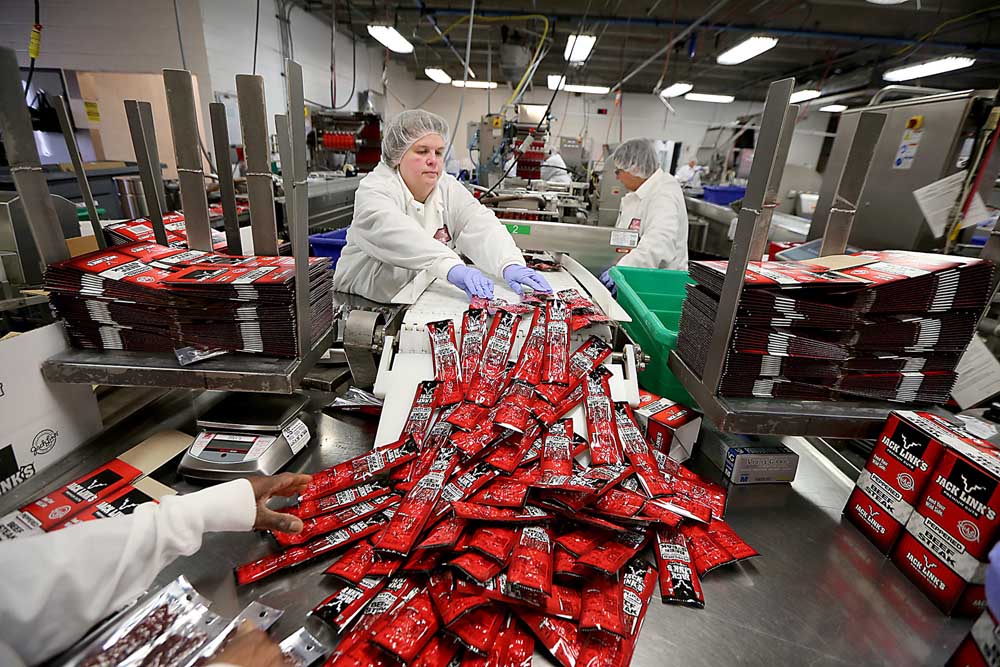Jerky giant Jack Link’s holds onto family roots
Published 12:00 am Sunday, November 8, 2015

- Elizabeth Flores / (Minneapolis) Star TribuneWorkers process Jack Link’s beef jerky in the packaging area in Minong, Wisconsin. The company is a powerhouse in the jerky industry, bringing in more than $1 billion annually.
MINONG, Wis. — It’s fitting that Jack Link still raises cattle here, his Angus steers and heifers roaming the same scrubby farmland where he grew up.
Link put a new spin on an ancient food — jerky — about 30 years ago in this tiny town 140 miles northeast of Minneapolis. He hawked it at trade shows and built an ironclad distribution network through regional convenience stores.
Today, Link’s name is synonymous with meat snacks, and his Minong-based company is the nation’s largest beef jerky purveyor. “It really turned out to be beyond my imagination, beyond what I was thinking,” Link said. “The growth was huge.”
Link’s company does more than $1 billion in annual sales, dominating a jerky market that it essentially created. Its slapstick advertisements — featuring the jerky-loving Sasquatch — have cemented the brand’s popularity.
The meat snack business shows no signs of slowing. Indeed, jerky is riding two of the food industry’s hottest trends: protein and snacking.
Dried meat is, of course, high in protein, and protein is so popular these days that cereal-maker General Mills launched a version of Cheerios chock-full of protein. Plus, jerky is eminently portable, a food that fits in well with Americans’ increasing propensity to snack.
“Jerky has been at the center of what consumers have wanted for the last decade,” said Troy Link, son of Chairman Jack Link and the company’s CEO. Big food companies see that and are increasingly jumping into meat snacks.
Just this year, Hershey bought jerky-maker Krave, its first non-chocolate acquisition. Tyson extended its popular Ball Park hot-dog brand into jerky. And Hormel Foods has fashioned one of its signature meat products into dried, bite-size portions: Spam Snacks.
But Troy Link said nobody is as steeped in meat snacks as Jack Link’s: “We are the meat snacks experts. This is all we do.”
Reinventing the business
Jack Link’s also makes turkey jerky and chicken and bacon jerky these days, but the foundation is still the original all-beef variety.
The meat arrives at Jack Link’s Minong plant in lean chunks of round steak — 8 to 10 pounds each. It is sliced, seasoned and cooked for six to eight hours in ovens the size of a small garage.
The Minong plant, long ago supplemented by other Jack Link’s factories, employs about 600. Since Minong’s population is only about 530, Jack Link’s draws employees from Spooner, Hayward and other northwest Wisconsin towns.
Jack Link has a residence in Florida, but he still lives a good part of the year in Minong. On a trip around town he pointed out his sprawling green rambler, the letters “J” and “L” plastered on the front, painted white like the trim.
Behind the wheel of a new Ford F-150, he drove past a Main Street bar where his parents’ house once stood and a battered old home where his grandparents had lived.
Link traces his roots in Minong to the 19th century when his great-great grandfather, a sausage maker, arrived from Germany. Jack was born in 1946, the same year his dad and his uncle started a Ford dealership in town, which Jack now owns.
He worked at the dealership growing up, as well as on the family farm tending cattle and at the Links’ general store, which peddled furniture, appliances and meat. The store carried 47 varieties of sausages, sides of beef and beef jerky — all made by the Links. But by the mid-1980s, the Link slaughterhouse had filed for bankruptcy.
Jack Link focused on beef jerky, a favorite of hunters and fishermen. He figured the core sportsmen’s market could be better tapped with a wider distribution network.
So he created an individually wrapped strip, or “steak” as the company calls it, that is thicker and more tender than traditional jerky. In fact, technically, it’s not jerky.
Holiday Station stores, one of the region’s largest convenience store chains, took the product. “That was a big deal,” Link said. SuperAmerica signed on, too. So did QuickTrip. “We grew up in the convenience store.”
Link quickly added flavored jerky steaks — teriyaki, pepper, sweet and hot — and created a meat stick packaged with a cheese stick. Then, he began producing small bags of traditional beef jerky. The distribution network grew big-time, too, as the Wal-Marts of the world signed on.
“It just kept expanding,” he said, and the sportsmen’s favorite became a mass market hit.
Managing a global brand
Jack Link’s is now a global company. Aside from Minong, Jack Link’s has five other U.S. facilities, including plants in Mankato, Minnesota, and Alpena, South Dakota, site of its largest operation. With 15 percent of sales from international markets, Jack Link’s also has plants in Germany, New Zealand and Brazil.
Jack Link’s growing marketing and sales department is now largely based in Minneapolis, where Jack Link’s employs about 130 people. Troy Link shuttles back and forth from Florida, where he lives, to Minneapolis and Minong, where he also has a residence.
Jack Link’s has almost 60 percent of the U.S. jerky market, according to Chicago-based market researcher IRI. The closest competition is private brands, which account for 10 percent of jerky sales.






